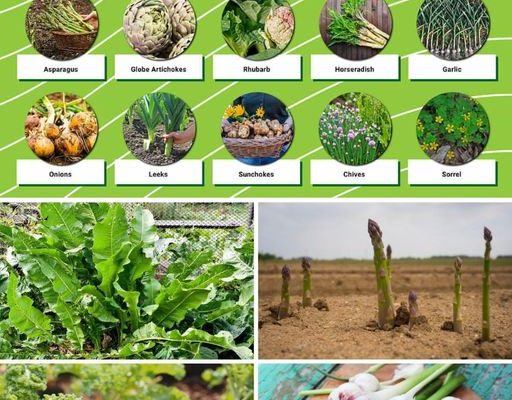Perennial Edibles: 10 Food Plants That Come Back Every Year
Embrace the ease and sustainability of perennial edibles in your garden for a continuous bounty with minimal effort. Unlike annuals, these plants return each year, providing a reliable source of homegrown produce. Here’s a guide to ten remarkable perennial edibles that will grace your table season after season, complete with planting advice, care tips, and harvesting techniques.

Asparagus (Asparagus officinalis):
- Characteristics: Early spring spears followed by fern-like foliage.
- Planting Guide: Plant crowns in early spring in well-drained soil, preferably in full sun.
- Care Tips: Water regularly and allow plants to establish before heavy harvesting.

Rhubarb (Rheum rhabarbarum):
- Characteristics: Tart, red stalks with large green leaves.
- Planting Guide: Plant crowns in early spring in fertile, well-drained soil, in a sunny or lightly shaded location.
- Care Tips: Consistent watering during dry periods and leaving two-thirds of stalks on the plant after harvesting.

Jerusalem Artichoke (Helianthus tuberosus):
- Characteristics: Edible tubers and tall sunflower-like blooms.
- Planting Guide: Plant tubers in early spring in well-drained soil, in full sun.
- Care Tips: Regular watering and harvesting tubers after the first frost for optimal flavor.

Chives (Allium schoenoprasum):
- Characteristics: Hardy herbs with mild onion flavor and edible flowers.
- Planting Guide: Plant in early spring or fall in moist, well-drained soil, in full sun or partial shade.
- Care Tips: Regular watering, cutting back in winter, and dividing clumps every 3-4 years.

Mint (Mentha spp.):
- Characteristics: Aromatic herb with various culinary uses and vigorous spreading.
- Planting Guide: Plant in contained areas or pots in spring, in partial shade and moist, well-drained soil.
- Care Tips: Consistent watering, cutting back before winter, and harvesting leaves before flowering.
Oregano (Origanum vulgare):
- Characteristics: Hardy herb with zesty flavor and small white flowers.
- Planting Guide: Plant in well-drained soil in a sunny spot, in spring or fall.
- Care Tips: Regular watering, avoiding overwatering, and harvesting leaves before flowering.
Sorrel (Rumex acetosa):
- Characteristics: Tangy, lemon-like flavored leafy green best harvested young.
- Planting Guide: Plant in early spring in moist, well-drained soil, in full sun to partial shade.
- Care Tips: Regular watering, removing flowers for continuous leaf production, and harvesting outer leaves.
Kale (Brassica oleracea):
- Characteristics: Nutrient-rich leafy green, more flavorful after frost.
- Planting Guide: Plant in well-drained soil rich in organic matter, in full sun or partial shade.
- Care Tips: Consistent watering, mulching for moisture retention, and harvesting outer leaves.
Globe Artichokes (Cynara cardunculus var. scolymus):
- Characteristics: Large, edible flower buds with striking appearance.
- Planting Guide: Plant crowns or rooted suckers in spring in well-drained soil, in full sun.
- Care Tips: Deep, regular watering and harvesting buds before opening.
Blueberries (Vaccinium spp.):
- Characteristics: Sweet, nutritious berries requiring acidic soil.
- Planting Guide: Plant in early spring or fall in a sunny spot with acidic, well-drained soil.
- Care Tips: Regular watering, acidic mulching, and pruning in late winter for optimal fruit production.
Incorporate these perennial favorites into your garden for sustainable, low-maintenance gardening, and enjoy a continuous harvest year after year. Embrace the abundance and continuity that perennials offer, enriching both your garden and your table with each returning season.




